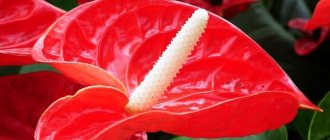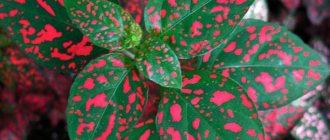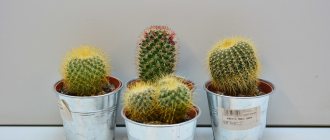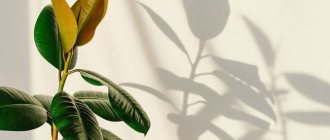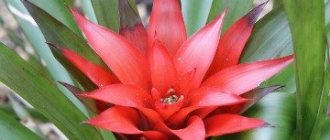Beneficial and negative properties of begonia
Esotericists have been studying the influence of begonia on humans for a long time. They agree that a lush, healthy bush can save household members from many problems relating to different areas of life. But sometimes a flower can cause harm.
Benefit
The positive influence of the flower is evidenced not only by folk signs, it has been scientifically proven. The bush actively absorbs carbon dioxide and releases phytoncides into the air, which stimulate the immune system, improve mood, and increase human performance.
The aroma of begonia calms and helps you fall asleep quickly. A person who keeps this flower at home feels a surge of strength and vigor during the day, remembers information faster, and becomes balanced.
Harm
If we take into account only folk beliefs and signs, then begonia can be kept at home, but we must not forget that it is a poisonous plant. Its leaves and stems contain toxins that can cause poisoning if ingested. This should be taken into account by those who want to grow a bush in their apartment in order to experience its magical effect. If there are animals and small children in the house, you will have to place the pot higher or abandon it altogether.
When caring for a tropical beauty, you need to wear gloves so that the juice from its leaves does not get on your skin. After transplanting, pinching and other manipulations with the bush, you need to thoroughly wash your hands with soap - if it gets on the mucous membranes of the eyes or mouth, the juice can cause a burn.
Healing properties
The plant is used in folk medicine:
- tubers - as an anesthetic and antispasmodic;
- infusion of flowers - for healing ulcers, burns, traumatic skin injuries;
- crushed leaves are applied to sore nipples;
- Begonia picta juice is taken orally to relieve headaches, treat stomach or duodenal ulcers;
- Freshly squeezed or crushed flowers and leaves of Begonia semperflorens draw pus from wounds and abscesses.
Signs with good meaning
Esotericists are unanimous in the opinion that begonia has positive energy. There are many signs associated with it that prophesy positive changes in the lives of its owners:
- the bush improves relationships between loved ones;
- helps avoid conflicts at work;
- helps to increase vitality;
- relieves diseases;
- protects against the negative influence of magic;
- According to legend, begonia helps to meet love and strengthen an existing marriage;
- gives financial well-being and happiness to household members;
- awakens creativity in people;
- helps to achieve success in business and move up the career ladder at work.
Seven steps to success
Tuberous begonias grow well and bloom only in conditions that are comfortable for them. When growing and storing them, you need to consider the following points.
- Sudden changes in illumination are harmful to them. A bright place, shaded at midday from the hot rays, is best on the balcony. You must make a mark on the pot and do not change the position of the pot in relation to the light, otherwise the buds may fall off. In a flower garden, begonia will feel good in light partial shade, where there is no wind and enough sunlight.
- Before planting in a permanent place, plants need to be hardened off in the shade outdoors for about two weeks. Moreover, for the first week, bring the pots indoors at night or cover them with spunbond or lutrasil.
- The watering regime is determined by the condition of the soil - it should be moderately moist all the time. In this case, water should not get on the tuber itself. You should not water the soil that has warmed up during the day with cold water - the root system will hurt and the plant may die. Water the begonias in the morning with warm, settled water. When planting, it is good to add hydrogel, perlite or vermiculite to the soil to retain moisture.
- Since water getting on leaves and especially flowers leads to the appearance of dark spots, to increase humidity it is necessary to spray the air around the plants or place containers with water nearby.
- They can be planted in the ground no earlier than the beginning of June: young begonias are sensitive to frost and can easily die even from a short drop in temperature.
- After the bush sheds its leaves, the stems are allowed to dry out. Then the tubers are removed from the ground and stored all winter in a dark, cool place. To prevent them from drying out during wintering, they must be placed in a box with peat or sand.
- Young tubers are not put to sleep for the first year: they are very small and dry out during storage. Even if a young begonia has shed its leaves on its own, it should be kept on a bright windowsill and lightly watered. In a week she will produce a new shoot.
Negative superstitions
The tropical guest, as an indicator, helps to identify existing problems in the family, as well as predict the near future. Here's what folk signs can prophesy:
- Deterioration in the appearance of leaves warns a person against future troubles.
- If the flower petals suddenly turn pale, it means sad news will come.
- A bush withers with good care - a bad omen, predicting material losses or illness. A flower gradually loses its beauty when there is a lot of negative energy in the house, quarrels and scandals often occur if the hearts of household members are filled with anger.
- The sudden death of a bush means that one of the family members has been cursed or damaged. Begonia dies when it absorbs this negativity, thereby protecting its owners.
Read also: What are the benefits and harms of the flower “Mother-in-law’s tongue” according to signs
Transplantation and propagation
Is it possible to keep a Crassula at home?
So, growing a flower involves not only proper care, but also replanting, which is periodically necessary for the plant. This procedure is performed when the flower has already grown enough and a larger pot is required, or when the soil is completely depleted and the flower needs new soil.
There are no special requirements for the soil. You can buy soil at a gardening store or make it yourself. In order to create good soil for a plant, you need to follow several rules:
- the pot is half filled with leaf soil;
- peat and black soil are added in equal proportions;
- Sand is placed at the bottom of the pot.
If you properly prepare the soil, the plant will grow quickly and correctly and delight you with its flowering.
It is necessary to ensure that the roots fit freely in the pot. As soon as they become crowded, the flower requires immediate transplantation. Early spring is best for this. In order to make a transplant, you need:
- remove the plant from the old pot;
- clean the roots from old peat;
- place the flower in water with potassium permanganate;
- trim off rotten parts of the roots.
It is important not to fill the pot full of soil. It is necessary to wait for the roots to dry completely and add the required amount of soil
A newly transplanted plant requires regular watering. There is no need to place the flower on the sunny side, as after transplantation it is in a state of stress. He needs to be given time to get used to his new habitat. Transplanted begonia care at home requires more painstaking care. As a rule, adaptation takes up to 1 month.
When the flower has grown sufficiently, we can talk about its reproduction. This process can be carried out in 3 ways:
- Leaf cuttings;
- Stems;
- Dividing the bush.
Each type has its own characteristics. If you neglect these rules, then the begonia will not only not bloom, it simply will not live. Tuberous plants reproduce by seeds or tubers.
Propagation by tubers:
- remove the tubers from the ground; this should be done in the autumn;
- trim leaves;
- clean the roots;
- place the peeled tubers in peat;
- keep the plant at a temperature not exceeding 11°C.
To germinate the first shoots, the plant must be transplanted into a pot with sandy soil. Next you need moderate watering.
This begonia germinates very slowly. Therefore, it is necessary to wait for the roots and first shoots.
If everything is done correctly, then sooner or later the flower will begin to grow, bloom and multiply. Do not forget that this is a living organism and you also need to monitor it.
What is known about the flower
This plant is found in the tropics and subtropics of Asia, Africa, and Madagascar. It grows in moist, warm environments. Flowering usually occurs in late spring or summer. The main condition for the development of buds is an air temperature of about +18...+24 degrees.
Popular types of indoor begonias:
- ever-blooming;
- coral;
- bright red;
- lorrain;
- elatior;
- brindle;
- royal.
According to legend, if begonia elatior suddenly blooms in the cold season, this foreshadows the owners of material prosperity and successful resolution of life situations.
A great variety of begonia species
Today, flower growers cannot come to a unified systematization of this type of plant. They are mainly classified according to the following criteria:
- by method of application: indoor and garden types;
- by the difference in root structure: fibrous, tuber-shaped, branched;
- according to the characteristics of the shoots and the characteristics of their growth: the shoots are straight, branched; reed; lodging with thick shoots; rhizomatous and others;
- by method of reproduction;
- according to biological characteristics.
Indoor begonias come in deciduous and flowering varieties. The rules for caring for them have a slight difference.
Begonia filters negative energy
According to esotericists, the bush is able to neutralize the harmful effects of black magic. It protects its owner from the dire consequences of such actions:
- damage;
- evil eye;
- love spell;
- lining
If you trust signs, this green beauty from the subtropics gradually removes negativity aimed at a person through magical rituals. The bush is able to cleanse the space of the house from the energy of envy and protect household members from the destructive influence of evil tongues.
Sudden wilting of leaves or dropping of petals is a bad omen. It is believed that the plant begins to rapidly wither when it absorbs a lot of negative energy sent to the owner. This happens when a person is damaged. The flower intensively absorbs this energy, protecting its owner, and itself quickly dies.
Begonia - protector of the home
The flower absorbs everything bad that has accumulated in the surrounding space. Negative emotions of household members, bad energy - everything passes through itself, like a filter. The plant will protect the owners from the bad intentions of uninvited guests, damage and the evil eye. The flower can cope with love spells, magical rituals and slander.
According to superstitions, the leaves of a flower curl when it is saturated with the negativity of guests who are ready to harm the owners of the house, but soon the begonia is restored. The plant puts up an impenetrable wall, a shield from everything that can bring harm to household members: from envy, evil intentions. The flower, like a warrior, stands guard over the peace of home and family.
Feng Shui meaning
According to the teachings of Feng Shui, begonia fills with energy not only the elderly, but also weakened people who are sick or have recently undergone surgery. If you leave a potty in such a person’s room, over time he will recover, become more cheerful, more active, and gain a desire to live.
According to Feng Shui, begonias belong in offices or work rooms. The plant helps to concentrate and stimulates brain activity. If conflicts often occur between employees, it will help smooth out relations. It is obvious that the science of Feng Shui and folk signs attribute the same properties to the plant.
Why are they grown?
Of course, the main function of begonia is to decorate the interior of your home (you can learn about growing begonia at home here). These plants are actually very beautiful, and some are even original. Begonias are used in flower arrangements and simply kept on the windowsill. Some blooming begonias look like a bouquet of small roses. Others are striking with exotic-looking leaves.
On a note. People familiar with the beneficial properties of this plant use it as an air purifier, for example, in a room where they smoke. It, like a vacuum cleaner, draws in all the toxins.
However, there are those who grow begonia to attract good luck, love, prosperity and positive energy. All this is promised by folk signs and beliefs.
Choosing a place for the pot
Begonia loves bright light. Windows facing north are not suitable for placing the pot - it is too dark there in winter. You can place the flower on the windowsill on the southeast or southwest side. To prevent the leaves from being damaged by direct sunlight, it is necessary to slightly shade the bush.
When choosing a place for begonia, you need to take into account the interpretation of signs. A spouse's bedroom is suitable for a red bush. You can put any type of plant in the kitchen. If you place a begonia with pink buds in the dining area, then, according to the sign, quarrels in the house will stop.
The white variety is ideal for the living room, where household members get together to chat and relax. A bush located in this area of the house will promote mutual respect between family members.
Brief description and types
Begonia is a whole genus of plants in the Begoniaceae family, which includes more than 1000 species. The distribution area of begonia in nature is South America, Africa, India. This plant species was discovered at the end of the 17th century by the French botanist Charles Plumier in the West Indies. He gave the plant its name in honor of his companion Michel Begon.
A large number of species of this plant for use in floriculture can be divided into two main groups:
- Deciduous and decorative specimens have beautiful, irregularly shaped leaves of a wide variety of colors.
- Beautifully flowering varieties, densely dotted during flowering with complex rose-like or simple flowers of yellow, white, pink and red.
It is impossible to describe this flower because begonias are so diverse that each species requires an individual description.
Popular beliefs
The tropical plant is most attractive to women. Folk signs associated with begonia promise them personal happiness and an abundant life. The luxurious bush also has a positive effect on men - it helps them become successful, start a family, and achieve harmony in relationships with colleagues, parents, and children.
Read also: Everyday signs associated with the arrival of guests
For girls and women
According to signs and superstitions about begonia, a woman who has just met a man should not keep a flower at home. During the candy-bouquet period, this flower is not the best helper, as it will make feelings even, calm, like those of couples who have spent many years together. For a married couple who have been married for a long time, begonia, on the contrary, will help revive youthful passion.
By plant type
There are several varieties of begonias, each of them has a special biofield. Depending on the species, plants influence different areas of human life.
Tiger
Growing tiger begonia is a good sign, because it helps its owners start life with a clean slate. The flower will put an end to all adversity and bring positive changes to life.
According to legend, you need to place a tiger variety in the bedroom of a sick person so that he recovers faster. It is recommended to do the same if you need to get rid of bad habits - smoking, alcoholism.
Coral
The sign about coral begonia is interpreted as follows - its owner will experience well-being in almost all areas of activity. From the moment of acquisition, a person who becomes the owner of this type of flower will have a positive attitude, his energy level will increase, and he will achieve success in his studies and creativity. The appearance of many buds on a plant is a very good sign, which portends good luck in all matters.
Royal
One of the folk signs regarding the royal begonia promises a happy life for the family. The bush attracts prosperity to the house. This type of flower is especially useful for entrepreneurs. Those who grow it will be able to develop their business and make a good profit. According to legend, this type of plant gives enterprising people the ability to make the right decisions and choose reliable partners.
For men and women
Begonia can be owned by people whose marriage was concluded many years ago. The flower will remind you of forgotten feelings, help preserve them and strengthen them. An unmarried man will be lucky to meet a worthy soul mate if he has a pot of begonia at home. Girls who are not married are not allowed to grow a flower. When the marriage is concluded and time-tested, then, according to signs, you can breed a tropical beauty. If the plant blooms ahead of schedule, according to signs, pregnancy should occur. But superstition will not “work” in the case of artificial forcing to flower.
There are superstitions about changes in the character of a woman who cares for a plant, she:
- learns to save;
- spend money wisely;
- plan family expenses.
According to signs, begonia smooths out misunderstandings between spouses and gives peace and tranquility.
Signs depending on the color of the flower
The interpretation of signs about begonia also depends on its color. Knowledge of decoding will help you achieve what you want. The color of the petals affects a person’s life as follows:
- A plant with white flowers protects the family from bad influences from the outside.
- Yellow begonia, according to legend, protects against the effects of black magic - damage, the evil eye.
- A rose bush placed in the kitchen will help avoid conflicts in the family. Thanks to the plant, quarrels and disagreements between spouses, children and their parents will cease.
- The sign says that red begonia kindles passion between spouses and helps revive old feelings.
Signs related to money
The flower activates cash flows, removing negative energy that interferes with financial well-being. If you trust superstitions and signs, a begonia flower grown at home or in the office will help increase your income. It is especially useful for entrepreneurs. With the help of a tropical bush, business owners will find good partners, develop financial acumen, and the ability to correctly build strategies to achieve their goals.
Flower and well-being in the family
Begonia leaves resemble a heart. Perhaps that is why folk signs attribute to her the ability to revive love. Many couples have already experienced this mystical effect on themselves. A beautiful plant can really save a marriage from destruction.
The sign predicts strong family ties for the owners of the bush. There will be no squabbles, discord, misunderstandings between spouses. Even if a chill has appeared in the relationship, there is no need to give up on it. Begonia will reawaken cooled feelings - respect, passion, love, trust, the desire to be faithful.
If a husband and wife are experiencing a crisis in their relationship, according to a sign, you need to put a plant in the bedroom. After some time, peace will reign in the family again.
From diseases
The leaves secrete substances that kill certain types of microbes. Thus, the bush protects family members from infections that affect the upper respiratory tract. Those who have a green beauty growing at home are less likely to suffer from cardiovascular diseases and digestive problems.
Preparations based on begonia are successfully used to treat bruises, sprains and wounds. An extract from leaves and roots is used to make medicines for lung and gastrointestinal diseases.
Prediction
Based on the state of the flower, you can predict the future and determine the weather. The rapid growth of shoots, as well as the sudden onset of abundant flowering, according to the sign, foreshadows a new addition to the family. If a flower is properly cared for, but it gradually fades, this indicates a deterioration in the health of someone close. If signs of disease are clearly visible on the leaves or stems, the sign warns of impending troubles.
Interestingly, you can predict when it will rain based on the condition of the begonia. According to legend, before heavy rainfall, the tips of its leaves become wet. The plant seems to be crying.
In love
People who are tired of loneliness should get a luxurious bush. Signs predict that those who grow this bush will have excellent relationships with the opposite sex. Those who have been looking for a couple for a long time will find a loved one, and those who are already married will find mutual understanding. True, signs do not come true instantly, you need to be patient, you cannot rush things.
Read also: Is it possible or not to give socks according to signs?
Garden begonia - rules for planting and caring for perennials
The garden perennial plant differs from the indoor one in being more resilient: it tolerates any weather conditions well and grows in flower beds and gardens.
The color of garden begonia petals is varied: from soft white to deep purple. You can get acquainted with all varieties of garden begonia by studying the catalogs of nurseries or flower growers.
Garden begonia
The maximum height of a plant growing in open ground is 25 cm. To grow this beautiful perennial, you should learn the rules of planting and caring for it.
Planting garden begonia
The plant is a light-loving plant, but it cannot be planted in places exposed to direct sunlight. Under their influence, the perennial will develop more slowly and bloom poorly. It is best to place it in those areas of the garden that are covered by tall trees.
Do not plant begonias in direct sunlight
Having chosen a suitable place, you need to wait until June - planting can be done no earlier than this month. In June, the most favorable conditions for the plant are created: warm weather without sudden temperature changes, plenty of sunlight. If you try to plant begonia earlier, it will most likely die, since it does not tolerate even light frosts.
You can purchase ready-made begonia seedlings
To plant plants, use seedlings, which you can purchase at a nursery or grow yourself using seeds.
Features of care
“Begonia loves water and grows best in well-moistened soil.”
A small amount of compost or peat is added to the hole in the open ground; you can also use mineral fertilizers that contain phosphorus and potassium. When the plant is planted, the soil should be moistened so that the seedlings take root faster.
Planting begonias in open ground
Periodically, you should carefully loosen the soil around the perennial so that the root system receives oxygen. Begonia loves water and grows best in well-moistened soil. Immediately after planting, the seedlings are watered at least once every 3 days, and if the weather is hot and there is no rain, then they begin to water more often, not forgetting to loosen the soil after that. It is important to ensure that water does not stagnate in the soil - this can lead to rotting of the roots. To prevent this from happening, even at the planting stage, the bottom of the hole is covered with drainage material (gravel, expanded clay, coarse sand and others).
Begonia loves well-moistened soil
You cannot spray the plant with water - moisture accumulated on the leaves can cause brown spots to appear on them. In the fall, in order to prepare the perennial for wintering, the begonia is stopped being watered.
Winter plant care
With the arrival of cold weather, at the very beginning of October, the stems of the plant are cut off, leaving a part protruding about 3 cm from the tubers. Then they dig up the tubers themselves, bring them to the living room and leave them there to dry for 2 weeks.
After this period, the tubers are carefully but thoroughly cleaned of clods of earth and dried stems, and placed in a box where they will be stored until spring. Covered with sand. The box is placed in a cool place.
Begonia tubers are dug up for the winter
If you only need to save a few tubers, you can place them in the refrigerator.
Reproduction
Garden begonia is a tuberous plant. In order to plant a large flower bed with this plant, you can purchase several tubers and then propagate it.
When purchasing, you need to pay attention to the age of the planting material - it is best to choose young ones. Their diameter should not be more than 6 cm. Even shriveled tubers are viable if they have living eyes.
The diameter of a begonia tuber should be no more than 6 cm.
In winter, they are placed in a cool place in a container with wet sand. It is important to monitor the level of humidity - the sand should not be allowed to dry out completely, however, too much water can be harmful: the tubers will begin to rot.
Begonia tuber division
You can start planting them in a nursery at the very beginning of spring, so in May buds will already bloom on them.
Before planting begins, each tuber is carefully inspected and old roots are removed.
To disinfect them, the prepared parts are placed for 30 minutes in a weak solution of manganese or a 1% solution of hydrogen peroxide. Using this technique, you can also get rid of traces of mold on planting material, but first you need to carefully remove all the mold, trying not to damage the sprouts.
You don’t have to use folk remedies - in the gardening department they sell special products for treating perennial tubers, after which the plant will not only be disinfected, hardened and able to resist most diseases, but will also receive additional nutrition.
Tubers
Plants begin to sprout tubers at the end of winter. It also helps to increase the volume of planting material for the garden.
Procedure:
- A small box is filled with wet sand, then tubers are planted in it.
- After the first shoots appear, the tuber is cut. Each part must have at least 1 shoot.
- The cut areas are treated with crushed charcoal, then left for several hours to dry.
- After the specified time, the seedlings are planted in pots.
Germination of begonia tubers
Plants need the same care that is required when growing seedlings.
The tubers of the perennial grow each year as they accumulate a lot of nutrients. At the same time, begonia flowers increase in size.
Garden begonia can be planted not only in flower beds - it is also used for landscaping balconies, window sills, and open terraces. If you grow a perennial intended for open ground in a pot, it will bloom just as luxuriantly.
Begonia can be used to decorate window sills at home
Cuttings
Adult garden begonia can be propagated by other methods:
- The sprout that appears on the sprouted tuber is carefully removed and planted in a glass filled with a nutrient mixture. It should rise only a couple of millimeters above the soil surface. With this method, the sprout will take root fairly quickly and you can get up to 6 individual plants from one tuber.
- From the perennial, cut off the upper part of the shoot, which has 6 leaves, and remove all buds and flowers. The cut area is coated with a rooting agent, which can be purchased at the store. You can also use a homemade one, which is suitable not only for begonias, but also for all flowers (both indoor and garden). To prepare it, dissolve a teaspoon of aloe juice and honey in half a glass of water. The finished product can be stored for no longer than 48 hours. The treated cuttings are placed in moist soil, a plastic bag is pulled over the pot or covered with film. Rooting occurs over the next week, after which the package is removed.
Germination of begonia cuttings
If there is high humidity in the room where the pot is located, it is necessary to ventilate it regularly. Otherwise, the perennial may develop powdery mildew. Signs of this disease are voluminous fluffy white spots. If such symptoms are detected, diseased sprouts are destroyed by burning them, and the remaining healthy plants are treated using a manganese solution.
Begonia can be planted in a flowerbed 2 months after growing it on the windowsill. Patterns made up of flowers of the same type look impressive and beautiful.
After 2 months, the cuttings can be planted in the ground
Plants should be planted at a distance from each other not exceeding 20 cm - in this case, perennial bushes will quickly cover the entire flowerbed with a continuous carpet. After all the seedlings are planted, the ground is mulched so that the soil does not dry out.
For this purpose, you can use sawdust, expanded clay, peat - in this case you will not have to loosen the soil, and you can water it less often. In summer, the plant needs to be fertilized with universal compounds for flowering plants. It needs to be done twice a month.
Compatibility with Zodiac signs
Astrologers attribute the flower to the fire element. In their opinion, the plant is ideal for Sagittarius and Leo. It will make these people more reasonable, attentive, and tolerant.
Capricorns, Gemini and Libra will be able to overcome difficult life stages thanks to the tropical bush. The plant is not energetically suitable for representatives of the signs Pisces, Cancer and Scorpio; it is better for them not to keep it at home.
The basis for growth and flowering is soil
Slightly acidic, loose and light soil will be favorable for the plant. It can be made from leaf soil, peat and sorbitol (in a ratio of 2:2:1).
You can buy a soil mixture specially prepared for begonias in the store. You can also add fine moss and humus. These components will improve the composition of the mixture.
Care advice from experts
A guest from the tropics has strong energy, but in order for its magical power to fully manifest itself, it is necessary to provide the plant with high-quality care. Experts advise not to let the soil in the pot dry out and place it in a well-lit place. A guest from tropical countries is comfortable with high humidity, but it cannot be sprayed, otherwise brown spots will appear on the leaves.
It is best to place the begonia in a tray filled with water on pebbles or expanded clay. Every year the bush needs to be replanted into a pot whose diameter is 1-1.5 cm larger than the previous one. Fertilizer for ornamental flowering species is used for feeding. It is applied once every 2 weeks, starting from the moment the buds form.
Most popular types
There are almost 900 varieties of this perennial, about 2,000 hybrids have been bred. Indoor crops can be divided into 2 types: flowering and deciduous. A characteristic feature of the latter is the unusual shape and color of the leaves. Flowering ones are divided into subgroups: bushy, tuberous, evergreen. The most popular types are:
- Ever-blooming. This variety of begonia, classified as bushy, can exist both in the garden and at home. When maintained at home, it may not stop flowering all year round. Signs: reddish or green leaves, small white, red or pink flowers.
Everblooming begonia
- Tuberous. A plant with double yellow, orange, white, juicy red or pink flowers of simple shape. Petals - with a border or two-color. The flowers are large, can reach 15 cm, and are similar in shape to peony, rose and carnation.
Tuberous begonia
- Royal. This variety of begonia, belonging to the group of decorative deciduous plants, grows up to 30 cm. It has leaves colored dark green, red or brown. The leaf shape is heart-shaped or spiral-shaped.
Royal begonia with spiral leaves
- Elatior. The tuberous hybrid is suitable only for growing at home. The shoots of the plant are thin and red. The flowers reach 5 cm in diameter. Petals can be red, white, orange or yellow. The leaves are round and glossy. The flowering period occurs in autumn and winter.
Begonia Elatior for growing at home
- Ampelnaya. Also refers to tuberous. Designed for vertical gardening: the shoots hang down 25–50 cm, bearing orange, crimson, white or yellow flowers that continue to bloom throughout the growing season.
Ampelous begonia
What does a dream about a flower mean?
If you dreamed about begonia, the omen promises favorable changes in your personal life. Single people will definitely find a person dear to their hearts who will reciprocate their feelings. A man will meet a loving girl who can create comfort in his home and fill his life with bright colors. For a woman, this sign portends increased attention from the opposite sex. She will hear long-awaited compliments or receive a marriage proposal.
The green beauty is a welcome guest in every home, because she protects the family from evil, helps to find a soul mate, strengthens the bonds of love and brings abundance. Under the influence of a luxurious bush, housewives will become less wasteful, men will achieve success in their careers, and the elderly will feel a surge of strength. However, it is important not to forget about the other side of the coin - this type of plant is poisonous, so it must be handled with care.
How to preserve the “magic power” of begonia?
In order for a flower to show its abilities and properties, as popular superstitions convey, it needs care and attention. Caring for the plant is simple:
- Find a comfortable place, away from drafts.
- Water in time when the top layer of soil dries out.
- Periodically feed with special fertilizers for begonias.
- You need to talk to the flower and not deprive it of attention. He is a living organism.
With such simple care, the tropical beauty will protect the home and family, help the sick recover and those in need cope with difficulties.
When your soul is very heavy, when there is no one nearby who wants to speak out or “cry into your vest,” you can share it with a tropical friend. Tell the begonia everything that has accumulated. Superstition says that the flower will help, take on all the pain, and your soul will feel lighter. In addition, the plant will thank the one who cares for it and shares its most secret things.
Chemical composition
The green parts of begonia contain an abundance of various micro- and macroelements. Among the main ones:
- potassium, calcium, magnesium and zinc;
- organic acids;
- proteins and sugar;
- saponins;
- alkaloids;
- slimy, resinous substance.
All parts of the plant contain acids: succinic, ascorbic, and some varieties contain oxalic. The leaves of the plant contain fatty acids (oleic, linoleic).
Reference! The rich chemical composition of begonia is a source of effective treatment. All green parts of the plant are widely used in traditional medicine; pharmaceutical preparations are made from them.
How to control pests
Despite the danger posed by parasite infestations, they can be successfully combated. Pests multiply very quickly and feed on sap. Therefore, ignoring the problem can cost the life of the plant.
Greenhouse whitefly
Maintaining constant air humidity (up to 70-80%) and soil is fraught with the appearance of insects. They live under the leaves. This is characterized by discoloration of the green plates, their drying out and death.
Using a soap solution will help. Before spraying, you should cover the soil with polyethylene and put the flower in “quarantine” so that the infection does not spread to neighbors on the windowsill.
Root nematode
Strange growths and bumps all over the plant are the first sign of root-knot nematode infestation. Small worms stop the flower from growing and cause rotting.
Preventing pests is easier than treating them. Therefore, before using the soil for planting, it must be steamed in the oven to kill the larvae. They can remain there in a dormant state for a very long time.
If nematodes are detected, all affected areas are removed and the plant is transplanted into sterile soil. The rhizome is watered with Heterophos solution at a concentration of 0.2%. 100 ml is enough for one medium pot.
Leaf nematode
It differs from the gall type in that it affects the above-ground part. The presence of worms is manifested by the appearance of light green spots on the leaves, which become brown over time.
It is almost impossible to combat this pest, and the begonia will most likely die. But at an early stage there is a chance to save the flower if you spray it with Heterophos 0.2% solution.
Soft scale insect
One of the most dangerous pests for begonias. It settles inside the shoots, stopping their development completely and contributing to the drying out of the plant.
First of all, you need to clean the false scale insect mechanically with a soft brush. An infusion of garlic used to treat the crown will completely help get rid of the parasite, having first protected the soil with polyethylene.
Red tick
The presence of a thin web will indicate the appearance of a red mite. With severe damage, a marbled color appears on the leaf blades. Gradually the begonia turns yellow, thins out and dies.
Ideal conditions for attack by this pest are abundant watering, dry air and heat.
To combat it, Decis is used, which is sprayed on greens according to the instructions on the package. To a greater extent, treatment should be carried out on the underside of the leaves, where parasites settle.
Aphid
It is dangerous because it sucks the juice from the flower and multiplies at high speed. With a massive pest invasion, begonia dies very soon. This is characterized by yellow curled leaves that quickly fall off, as do the buds.
Aphids can enter a room through an open window. Fufanon helps to cope with the parasite.
Important : treatment cannot be delayed. It must be urgent, otherwise the harm caused will lead to another problem. Over time, a sooty fungus appears on aphid excrement, which is even more dangerous, and in 98% of cases leads to the death of the flower.
Thrips
Large insects, visible to the eye. The leaves become discolored and crown development stops. When the air is too humid and hot, the parasite multiplies faster.
It is recommended to fight thrips with a soap solution, tobacco infusion, celandine (100 g of raw material per 1 liter of liquid).
Useful tips
- Feng Shui masters advise placing several protective amulets next to the begonia to neutralize negative energy.
- Home gardeners advise removing begonias from doors and windows. You need to purchase a bush only in a specialized store.
- Bioenergetics specialists advise not to plant begonias in a house where there are unmarried ladies. A flower can neutralize love, despite the positive message.
If you treat the plant with love and care for it correctly, the green pet will delight you with abundant flowering and enrich it with positive energy. Despite several negative superstitions.
Contraindications and risks
The main contraindications for starting treatment with begonia are pregnancy and lactation, early childhood and adolescence, individual intolerance and a high tendency to allergies. Also, you should not start treatment during an exacerbation of chronic illnesses or during an epidemic of ARVI or influenza.
Pure begonia juice should not be drunk or applied to open wounds. It is not recommended to eat the leaves, but the flowers and tubers can be eaten, but with extreme caution, following the dosage and medical prescriptions.
Begonia is an amazing house plant. It will effectively clean and humidify the air and neutralize chemical fumes. The green parts are used to treat various pathologies. But begonia can also cause harm. It is forbidden to start treatment without first consulting a doctor.
perennial annual
Always blooming begonia (B. semperflorens) is perhaps the most elegant, compact and long-blooming flowerbed annual, easily transplantable, retaining its decorative appearance in hot weather and not afraid of wind, rain and shade. Its flowers are double and single, in all shades of red, pink and white. Some varieties impress not with their blooms, but with their shiny leaves that are deep green, purple or bronze. There are very beautiful variegated varieties, as well as those with long hanging vines, these can be grown as ampels.
Extremely popular in European countries, widely in demand in our city landscaping, always blooming begonia is practically never used to decorate balconies and gardens. And all because it is quite troublesome to grow it from seeds. To get flowering seedlings by the beginning of summer, seeds should be sown in January. Sown later, it will bloom closer to autumn.
The easiest way to get begonia that always blooms is to preserve the queen cell in winter. In the house she winters well on a bright windowsill. At the same time, it is important to protect the roots from hypothermia, and the crown from the heat and dry air of the radiators. In natural light, the plant will stop blooming in October and bloom again in late February - March.
KEEP IN MIND
If the purple foliage takes on green hues in winter, don't worry: the sun will restore its color in the spring.
In addition, cuttings are the only way to propagate terry varieties.
In March, the overwintered plant is cut short and fed regularly. After the begonia produces many new strong shoots, they are cut off a little diagonally, the lower leaves are removed (it will shed them anyway) and placed in cups of water. It is better if the cutting does not rest against the bottom of the container. Rooting usually takes about two weeks. When the cuttings produce roots, they are transplanted into cups with light, fertile soil.
Always blooming begonia tolerates transplantation well at any age.
The only drawback of the ever-blooming begonia, like its other close relatives, is its heat-loving nature. The smallest frost is enough for the succulent shoots with numerous leaves and flowers to die.
